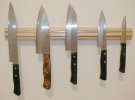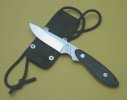light reflected means you are not sharp
not reflecting light does not mean necessarily that you are sharp. but you are getting closer.
I strop with a the same angle and very light pressure.
somebody mentioned you are juggling many plates in another thread, and I seem to agree.
I also believe you mentioned you have a fixed angle sharpening system on its way.....this is good in my opinion.
having, using, and learning a fixed angle system really helped me to understand sharpening.
not reflecting light does not mean necessarily that you are sharp. but you are getting closer.
I strop with a the same angle and very light pressure.
somebody mentioned you are juggling many plates in another thread, and I seem to agree.
I also believe you mentioned you have a fixed angle sharpening system on its way.....this is good in my opinion.
having, using, and learning a fixed angle system really helped me to understand sharpening.



